Special Feature: Products Sally Recommends
Driving a Porsche Cayman to Ben Nevis and Eriska in Bonnie Scotland
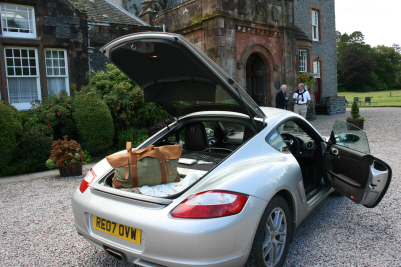 Ferdinand Porsche and Shigetoshi Miyoshi, two engineers a hundred years apart and from opposite ends of the globe, would probably have got on like a house on fire.
Ferdinand Porsche and Shigetoshi Miyoshi, two engineers a hundred years apart and from opposite ends of the globe, would probably have got on like a house on fire.
In the drive to find a greener but still powerful car, Miyoshi, chief engineer at Lexus, has spawned a hybrid. The twenty-first century GS 450h sports a 3.5 litre V6 direct injection petrol engine and a high output electric motor. The result is a staggering 340 b.h.p, rivalling that of a V8 but giving the economy of a 2 litre petrol engine.
Meanwhile Porsche, a century ahead of his time, presented to the Paris World Fair in 1900 the Lohner-Porsche electric car. Needless to say it created quite a stir. In the same year he also developed his own hybrid petrol/electric vehicle, following it up with a four wheel drive race car. Later, during the twenties, he went on to design the remarkable Mercedes Compressor sports car.
In the fascinating history of motor car development the Porsche family takes a bit of beating. By 1948 Ferry Porsche, Ferdinand’s son, launched the incomparable 356 and sixty years later the Porsche range of cars, particularly the 911, Boxster and Cayman, have evolved like antelopes with the same tell-tale characteristics of the 356 to hold their place at the top-table of motoring design.
A glimpse at the Cayman we have just driven into the Highlands of Scotland reveals those classic and desirable and even haunting lines that Ferry Porsche first brought to the starved world of motor cars just after the Second World War. Mid-engined, like the original 356, there was room in the back for a fishing rod, boots and waterproofs and at the front our two cases dropped easily into the well. No other two-seater sports car comes close to offering that sort of space. But here’s the good part. The Cayman was a joy to drive on the tight Scottish roads, holding on like a limpet and recording a very acceptable thirty miles to the gallon. You could drive it as hard as you liked or as gently as you liked and it didn’t mind a bit. One of our favourite tricks was to leave it in fourth or fifth gear and pull away from almost nothing. Like a true Porsche it laughed all the way down the road.
Our journey took us to Perth and Scone Palace where the Scottish Game Fair was taking place over a very wet weekend. We stopped off for a few hours on our way to the Highlands and enjoyed the huge range of exhibitors showing off their country clothing, picnic baskets, fishing tackle, guns, furniture, fly casting, clay pigeon shooting, gun dog demonstrations and all sorts of entertainment in the main ring. We were concerned about getting bogged down in the fields that were being used for parking so we persuaded the marshals to let us go right down into the heart of the fair where we found an excellent spot right next to the river. As we parked up to put our boots on it was clear that the car was capable of turning a few heads!
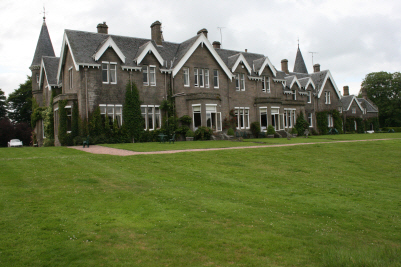 From there we had only a short hop to Ballathie House where we had booked for our first night. It sits overlooking the glorious River Tay one of the great salmon rivers of Scotland and from our room we watched the river turn the colour of milk chocolate after all the rain. This part of Scotland, east Perthshire, has a long history and Ballathie has been a name on the Ordnance Survey map for generations. The Romans came this way in the first century and had a fortification at Kinclaven, where the River Isla joins the River Tay. The Drummond family, the Earls of Perth, owned the Ballathie lands in the seventeenth century. They later sold them to the forebears of General Richardson Robertson of Tullybelton, who died in 1883. And then his nephew, Colonel E. R. F. Richardson, succeeded him and was instrumental in raising funds to build the Kinclaven Bridge over the River Tay. The bridge crosses by the famous Meiklour Beech Hedge, planted in 1746 and still standing.
From there we had only a short hop to Ballathie House where we had booked for our first night. It sits overlooking the glorious River Tay one of the great salmon rivers of Scotland and from our room we watched the river turn the colour of milk chocolate after all the rain. This part of Scotland, east Perthshire, has a long history and Ballathie has been a name on the Ordnance Survey map for generations. The Romans came this way in the first century and had a fortification at Kinclaven, where the River Isla joins the River Tay. The Drummond family, the Earls of Perth, owned the Ballathie lands in the seventeenth century. They later sold them to the forebears of General Richardson Robertson of Tullybelton, who died in 1883. And then his nephew, Colonel E. R. F. Richardson, succeeded him and was instrumental in raising funds to build the Kinclaven Bridge over the River Tay. The bridge crosses by the famous Meiklour Beech Hedge, planted in 1746 and still standing.
In 1910 the house was bought by Sir Stewart Coats from Paisley and enlarged with alterations to the two wings and the addition of a new front entrance porch. Central heating and electric lighting were also installed at this time. The famous golfer, Ben Sayers, laid out a nine-hole golf course, but sadly this and the cricket ground have both been ploughed up. When the railway came with the mainline route between Glasgow and Aberdeen, Ballathie had its own train halt. It was during this period that Ballathie was a renowned sporting estate, where many of the best shots in the land came to shoot grouse and catch salmon in the deep pools of the Tay. It is thirty five years since the house was converted to a luxury Scottish hotel, but when you stay there today there is still a very good sense of what the house was.
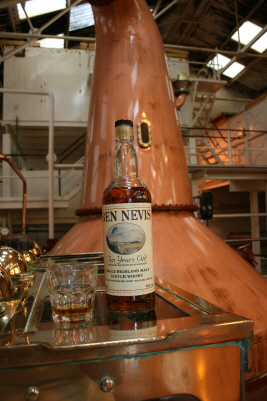 The next morning, after a lovely breakfast of porridge and bacon and eggs, we set off for Fort William and the Ben Nevis Whisky Distillery. The distillery sits at the foot of Britain’s biggest mountain and the managing director, Colin Ross, was waiting to greet us. In common with most whisky distilleries Ben Nevis has a visitor centre where a guide will take you round and see how the whisky is made. Then, of course, all you have to do is sample it with a view to buying a bottle or two.
The next morning, after a lovely breakfast of porridge and bacon and eggs, we set off for Fort William and the Ben Nevis Whisky Distillery. The distillery sits at the foot of Britain’s biggest mountain and the managing director, Colin Ross, was waiting to greet us. In common with most whisky distilleries Ben Nevis has a visitor centre where a guide will take you round and see how the whisky is made. Then, of course, all you have to do is sample it with a view to buying a bottle or two.
Leaving Ballathie we headed for Dunkeld on winding roads up the beautiful Tay valley. The Cayman behaved impeccably hugging every bend and eating up the miles. We also battled through torrential rain showers but the car was a delight to drive in such adverse conditions. Then we hit the A9 and that was our chance to open up the throttle and give the car a proper run. The engine, sounding as though we had Lauren Bacall chattering beside us, wafted us north in great style eating up the miles and making you feel that this was a car you could easily get used to. It seemed no time at all before the giant mountain of Ben Nevis rose before us and that meant we had arrived at the distillery.
The secret of making superb whisky has a great deal to do with the quality of water that is on hand. And, as Colin Ross will tell you, the water at the foot of Ben Nevis is the very best - clear and pure. To that you add barley and yeast and through the process of distillation you end up with a crystal clear spirit which goes into wooden casks to mature for a number of years. Only then does it become whisky, taking on the flavours of the wood. Looking round the distillery was a delight and in the company of guide John Carmichael, he made it doubly entertaining. The heart of any distillery is the still house where the great copper stills stand like giants and you can see the clear spirit pouring through the locked spirit safe. This makes sure that no one can steal the spirit from under the noses of the customs and excise men. Oh, and speaking of noses, the delicious smells as you walk around are enough to drive you to drink!
Our next destination was the Isle of Eriska about an hour to the south west. It’s a charming island which you reach by a Victorian iron bridge covered in timber planks over which you drive a little gingerly. Carry on 150 yards and the big house, now a very special hotel, appears before you. Like Ballathie this is another example of a building built for its spectacular location this time overlooking a sea loch and the wild Atlantic Ocean beyond.
Built in 1884 by James Meliss Stuart he had barely a year to enjoy the house before he died. And it was to be a number of years before the new owners of the house began to host beautiful parties in keeping with the trappings of wealth and privilege. The Clark Hutchison family took the house into the twentieth century and a golden period. In April each year two carriages were added to the Oban train at Edinburgh so that family and friends could begin their journey west for the summer. At Connell Junction they were disconnected from the rest of the train and shunted to the station at Benderloch where a coach and horses, and later a car or omnibus, would be waiting to take them the final leg. Here they would spend the months playing tennis, swimming and sailing in dinghies. Sometimes they went much further afield in the beautiful Arianna, a steam yacht of 347 tons with a complement of twenty five crew!
Decades later, when another family called the Buchanan Smiths first set eyes on Eriska in the early 1970s, the house had gone from being a desirable country residence into a sad, unkempt and unloved shadow of its former self. In fact it had deteriorated almost beyond belief and there was a question mark over whether it could be saved. All the more remarkable then that Robin and Sheena Buchanan Smith thought they could turn it into an hotel but that is exactly what they did and today their two sons, Beppo and Chay, have continued their father’s dream and developed it into one of the best hotels in Scotland.
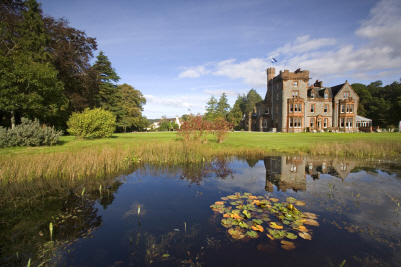 It was the perfect destination to drive to, following the roads that wind along the coast and then down a tiny narrow road to the old planked bridge that takes you on to the island of Eriska itself. Within a few seconds the house emerges from the trees and at last you have arrived. A log fire was alight in the hallway and Beppo was waiting to greet us in a smart chalk-striped suit, looking as though he’d just come home from the London stock exchange. “Welcome to Eriska,” he said with a smile. “Have a good trip?” “One of the best drives we’ve had,” we replied. Great countryside around here isn’t it.?” Beppo was keen to tell us about the otters that he regularly sees on the beach, the badgers that come on to the lawn at night and the rare pine martin living in the grounds. In fact he writes a regular blog on his website, telling everyone all about it.
It was the perfect destination to drive to, following the roads that wind along the coast and then down a tiny narrow road to the old planked bridge that takes you on to the island of Eriska itself. Within a few seconds the house emerges from the trees and at last you have arrived. A log fire was alight in the hallway and Beppo was waiting to greet us in a smart chalk-striped suit, looking as though he’d just come home from the London stock exchange. “Welcome to Eriska,” he said with a smile. “Have a good trip?” “One of the best drives we’ve had,” we replied. Great countryside around here isn’t it.?” Beppo was keen to tell us about the otters that he regularly sees on the beach, the badgers that come on to the lawn at night and the rare pine martin living in the grounds. In fact he writes a regular blog on his website, telling everyone all about it.
Our room was one of those that you instantly feel comfortable in. It had a large bed, squashy sofa and antique mahogany furniture. Our table for dinner that night was in the conservatory, which allowed us wonderful views of the gardens as the fading evening light settled into the trees. Excellent and very attentive waiters brought us a delicious dinner of lemon sole and chervil roulade as a starter followed by shallot, snow pea and spinach soup and for the main course roast gigot of Argyllshire lamb carved at the table. That was followed by an excellent cheese trolley and a rich chocolate pudding.
The next morning after our usual hearty breakfast Beppo showed us round. A short walk through the garden brings you to a most attractive indoor swimming pool, sauna, gym, treatment rooms and spa. There are also five spa cottages and two garden cottages for guests who want to be more independent. They make an attractive addition to staying in one of the sixteen bedrooms in the main house. There is also a very pretty golf course.
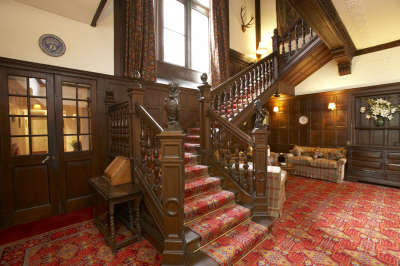 We were extremely reluctant to leave Eriska. There was so much we hadn’t done. Most of all we wanted to walk, take the air and lap up the scenery. The bird sound is extraordinary too – curlews call, oyster catchers pipe and skylarks, singing all the time, rise so high in the sky that they seem to disappear. “Come back,” said Beppo. We would like to. Let’s see now, perhaps we could try out a 911 Carrera or Targa or Cayenne! Yes, the Cayenne would do nicely. Perfect for carrying fishing rods and golf clubs.
We were extremely reluctant to leave Eriska. There was so much we hadn’t done. Most of all we wanted to walk, take the air and lap up the scenery. The bird sound is extraordinary too – curlews call, oyster catchers pipe and skylarks, singing all the time, rise so high in the sky that they seem to disappear. “Come back,” said Beppo. We would like to. Let’s see now, perhaps we could try out a 911 Carrera or Targa or Cayenne! Yes, the Cayenne would do nicely. Perfect for carrying fishing rods and golf clubs.
GETTING THERE
Keith and Lynne travelled from their home in Berwick upon Tweed in a Porsche Cayman.
For more details on this model and the full range of Porsche vehicles: www.porsche.com
WHERE TO STAY
Ballathie House Hotel
Kinclaven
Stanley
Perthshire
PH1 4QN
+44 (0) 1250 883268
email@ballathiehousehotel.com
Ballathie House Hotel is one of the finest 4 Star hotels in Perth, Scotland for touring.
Dunkeld, Blairgowrie, Scone Palace and Perth Racecourse can be reached within twenty minutes and Edinburgh, Pitlochry, Stirling, Glamis Castle and Dundee are all within the hour.
Royal Deeside, Speyside and Aviemore, Inverness, Fort William and the West Coast are typical day excursions.
Directions
By Road:
From M90
Continue on the M90 to the Broxden roundabout junction with the A9 to the west of Perth.
Join the A9, heading North, following signs for Pitlochry & Inverness.
Remain on the A9 for 4 miles.
Leave A9 at the slip road for Luncarty and join B9099 for 4 miles, continue through Stanley, and turn right a West Tofts, following the signs for Kinclaven and Ballathie House.
Motorway to Perth, (follow signs for Inverness) two miles north of Perth, take B9099 through Stanley, turn right at sign for Kinclaven (& Ballathie). OR off A93 at Beech Hedges, follow signs for Kinclaven (& Ballathie).
From Edinburgh
Take A90 and cross the Forth Road Bridge towards Dunfermline. Join the M90 and follow the directions above.
From Glasgow
Take A80/M90 towards Stirling. Join the M9 heading north to Dunblane. Join the A9 to Perth. Follow directions above.
By Air:
Edinburgh Airport is 50 miles (1 hr) away
Glasgow Airport is 75 miles (1 hr 30 mins) away
Helicopter landing area at hotel.
The Isle of Eriska,
Hotel, Spa & Island,
Ledaig,
By Oban,
Argyll,
Scotland,
PA37 1SD
Tel: 0044 (0)1631 720371
office@eriska-hotel.co.uk
Directions from Edinburgh and Glasgow
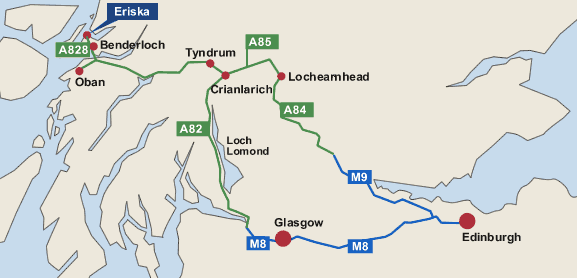
From Glasgow
Take the A82 out the city which will take you directly to Tyndrum, via Crianlarich. You then follow the A85 towards Oban. At Connel proceed by bridge onto the A828 (signposted
Fort William) for 4 miles until you reach the north of Benderloch village. You will then be clearly signposted to the Isle of Eriska.
From Edinburgh
Take the M8 out of the city and leave at Junction 2 for the M9. Exit at Junction 10 and follow the A84 to Lochearnhead. At Crianiarich take the A85 and follow it until you come to a junction for the A828 signposted Benderloch. Once you reach the north side of Benderloch village, you will be clearly signposted to the Isle of Eriska
RECOMMENDED READING
Portrait of Britain, published by Dorling Kindersley.
![]()
Husband and wife, Keith Allan and Lynne Gray are travel writers and photographers based in Berwick upon Tweed on the English/Scottish border. They have worked for The Times, Daily Telegraph, Financial Times, House and Garden, Scotland on Sunday and The Herald. For more than twenty years they have worked as freelance producers and reporters for BBC Radio, working from their own independent studio for BBC Radio 4, Radio 5 and Radio Scotland as well as the BBC’s World Service.
Note: This information was accurate when it was published. Please be sure to confirm all rates and details directly with the businesses in question before making your plans.



